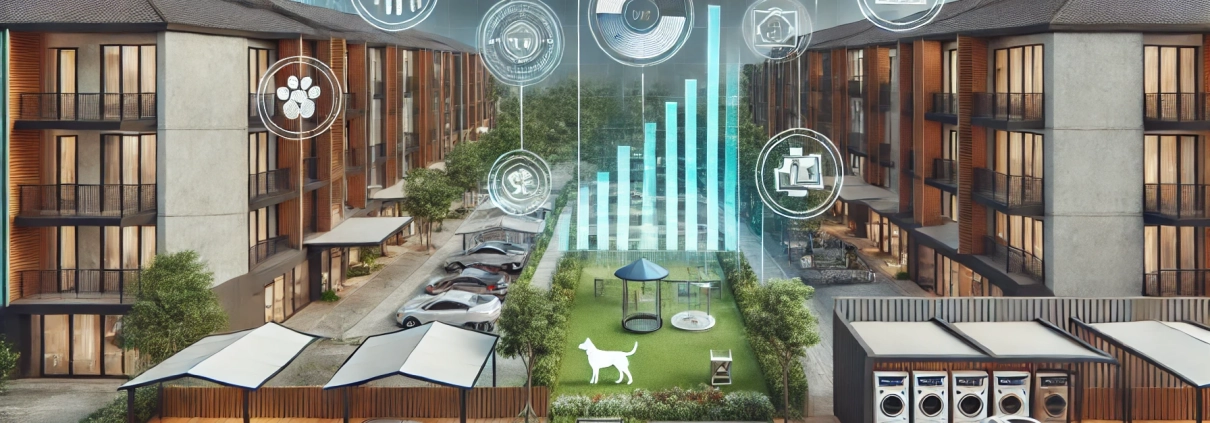Other Income
In real estate underwriting, Other Income refers to any revenue source not otherwise included in other income line items. Other income may include any number of revenue generators, from application fees to amenities fees. In the basic real estate pro forma setup, Other Income is combined with Total Rental Revenue to arrive at a Gross Potential Revenue line.
Putting ‘Other Income’ in Context
Scenario Overview
In this hypothetical scenario, Skyline Ventures, a real estate private equity firm, has acquired Prairie Heights Residences, a 150-unit market-rate multifamily property in Bismarck, North Dakota. Prairie Heights offers a mix of one-bedroom, two-bedroom, and three-bedroom apartments. The property has recently undergone light renovations to enhance its appeal to tenants seeking upscale amenities in the growing suburban market of Bismarck.
Other Income at Prairie Heights Residences
In addition to rental revenue, Skyline Ventures identified several opportunities to boost Other Income at Prairie Heights. These revenue sources were not part of traditional rental income but were essential for underwriting the investment. Below are the primary components of Other Income at the property:
- Application Fees: $50 per application, with an average of 20 applications processed per month.
- Pet Fees: A recurring $30 monthly pet rent, collected from 40 pet-owning tenants.
- Covered Parking Fees: $75 per month for 30 premium covered parking spots.
- Laundry Facility Income: Coin-operated laundry machines generate $1,000 monthly.
- Amenity Fees: Access to the community fitness center is offered at $15 per month, used by 50 tenants.
Calculation of Other Income
Here’s how the Other Income line item is calculated based on these revenue streams:
Monthly Other Income:
- Application Fees: 20 x 50 = $1,000
- Pet Fees: 40 x 30 = $1,200
- Covered Parking Fees: 30 x 75 = $2,250
- Laundry Facility Income: $1,000
- Amenity Fees: 50 x 15 = $750
Total Monthly Other Income: $1,000 + $1,200 + $2,250 + $1,000 + $750 = $6,200
Annual Other Income:
To annualize the Other Income, multiply the monthly total by 12:
$6,200 x 12 = $74,400
Integration with the Pro Forma
The Other Income figure of $74,400 is combined with the Total Rental Revenue to calculate Gross Potential Revenue for Prairie Heights Residences. This additional income stream boosts the property’s Net Operating Income (NOI), directly improving the property’s valuation and the investment returns for Skyline Ventures.
Frequently Asked Questions about Other Income in Real Estate Underwriting
What is "Other Income" in real estate underwriting?
In real estate underwriting, “Other Income” refers to any revenue source not included in standard rental income line items. This can include fees from applications, pets, parking, amenities, laundry, and more. It is typically combined with total rental revenue to arrive at Gross Potential Revenue.
What are common sources of Other Income?
Common sources of Other Income include:
Application fees
Pet rent
Covered parking fees
Laundry machine revenue
Amenity fees (e.g., fitness center access)
These vary by property type and tenant demand.
How was Other Income calculated at Prairie Heights Residences?
Skyline Ventures calculated monthly Other Income from various sources as follows:
Application Fees: 20 apps/month × $50 = $1,000
Pet Fees: 40 pets × $30 = $1,200
Covered Parking: 30 spaces × $75 = $2,250
Laundry: $1,000
Amenities: 50 tenants × $15 = $750
Total monthly Other Income = $6,200. Annualized = $6,200 × 12 = $74,400
Why is Other Income important in property underwriting?
Other Income is important because it increases Gross Potential Revenue, which in turn boosts Net Operating Income (NOI). Higher NOI leads to higher property valuation and stronger investment returns. It also diversifies income sources beyond base rent.
How is Other Income used in a real estate pro forma?
In a basic real estate pro forma, Other Income is added to Total Rental Revenue to calculate Gross Potential Revenue. This figure feeds into the overall income calculation used to estimate NOI and assess deal viability.
Click here to get this CRE Glossary in an eBook (PDF) format.

